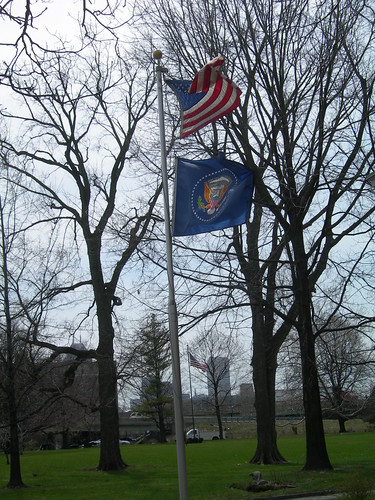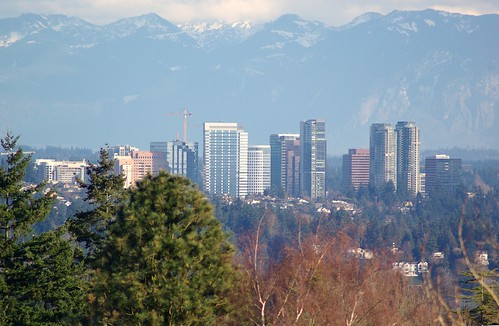I had a few hours available this afternoon, so I asked my trusty Neverlost Lady where I should go (though lately we've been having problems -- I think she suspects there's something going on between me a Judy Garmin).
Since I was in Indianapolis, she suggested the
President Benjamin Harrison house. Actually she suggested several museums, the brickyard, the state house and a few other things, but I figured parking would be easier at an attraction designed around a President most people have never heard of.

The house is a 16-room mansion. President Harrison bought it before he ran for president, and paid $4,000 for the land. Building the house cost another $25,000.
It looks a lot bigger on the inside than it does on the outside. The two main floors have 14' ceilings, and the top floor was a ball room. Inside, the property is beautiful and looks quite comfortable. What I find interesting is that houses that have been built in the last few years take up the same or bigger foot print, yet have fewer rooms or less effective use of space on the inside.
The volunteers do a nice job of showing off the various parlors, bedrooms, the library, kitchen, and other spaces. I wouldn't mind having President Harrison's home office (though they called it the library back then). It was filled with Harrison's actual books. He was a fan of other presidential administrations and of classics.
The house had two staircases. One was for the family and guests. The other one was for the servants in the back. The main one was large and easy to climb. The servants were not so lucky. They had a narrow, steep staircase with shorter stairs. It was a bit nerve wracking descending it.
I didn't take any pictures inside the house because it was all on a guided tour. The tour costs $8, and there were only two other people in the group. I felt awkward stopping to take pictures so i passed. The other weird thing is that the middle of the tour includes a visit to the gift shop, in what used to be the butler's pantry. The guided stops to give people the opportunity to shop. After you browse and make purchases, the tour continues.
The guide was informative, and I learned a lot on the tour, but I would have preferred the option to take a self guided tour, so I can wander at my leisure as I read every placard.
If you get the chance, stop by. It's an hour and a half well spent.
The guide talked to us about some of the key events in Harrison's presidency and campaign.
The one-term Republic served from 1889 to 1893. He served between President Cleveland's two terms, and was the only president to interrupt two terms of another president. He was also the only President to have a grandfather who also served as President. He came to office after losing the popular vote, but winning the electoral vote.
The campaign was quite different than the recent, 15 year long 2008 campaign we just survived. Harrison didn't seek out the nomination. He wasn't even in the same city as the Republican convention when they nominated him on the eighth ballot. He accepted the nomination in between two of the rooms we saw on the tour.
His campaign was one of the first front porch campaigns. Rather than travel among the 40 states, he entertained visitor and delegations on his front porch. At larger events, people would steal parts of his fence as souveniers.
During the campaign on 1893, his wife died of tuberculosis. He didn't campaign after that. Once he heard about it, his opponent, former President Grover Cleveland also stopped campaigning, rather than take advantage of the President's wife's death. Harrison did lose reelection.
His
White House biography, and
his Wikipedia entry highlight some of the key events of those four years Harrison spent in the White House.
He was the first President to have a Christmas tree in the White House.
He was the first President to advocate flying the flag on a regular basis.
He wrote the first version of the Pledge of Allegiance.
During his administration, for the first time ever, the US Federal Budget exceeded $1 billion. At the beginning of his administration, the budget showed a significant surplus, but he and the congress spent that down, in part by expanding pensions for Civil War Veterans.
One of the biggest political challenges was the question of what to do about tariffs.
From Harrison's Wikipedia page:
The issue of tariff levels had been a major point of contention in American politics since before the Civil War, and tariffs became the most prominent issue of the 1888 election.[66] The high tariff rates had created a surplus of money in the Treasury, which led many Democrats (as well as the growing Populist movement) to call for lowering the rates.[67] Most Republicans wished the rates to remain high, and to spend the surplus on internal improvements as well as the elimination of some internal taxes.[67]
Representative William McKinley and Senator Nelson W. Aldrich framed the McKinley Tariff that would raise the tariff even higher, including making some rates intentionally prohibitive.[68] At Secretary of State James Blaine's urging, Harrison attempted to make the tariff more acceptable by urging Congress to add reciprocity provisions, which would allow the President to reduce rates when other countries reduced their rates on American exports.[66] The tariff was removed from imported raw sugar, and sugar growers in the United States were given a two cent per pound subsidy on their production.[68] Even with the reductions and reciprocity, the McKinley Tariff enacted the highest average rate in American history, and the spending associated with it contributed to the reputation of the Billion-Dollar Congress.[66]
That's right. The Democrats were calling for lowering taxes and the size of government. The Republicans were resisting those initiatives, and supported using the surplus to expand social programs. The Republicans pushed for protectionist tax measures; the Democrats supported free-er trade.
He signed the Sherman Anti-Trust act and expanded the US Navy in the Pacific. He had major foreign policy initiatives with other countries in the Americas, and nearly got the US into war with Chile.
It may have been a short 4 years, but the legislation and initiatives Harrison pursued have had a significant impact on today's economy. The impact of the Harrison administration is much broader than I recalled from high school.
As we deal with the economic challenges the country faces today, it may be time to take a closer look at what happened during Harrison's administration and the Panic of 1893 that followed his administration.
And it's all because the Neverlost Lady showed me a quirky option.
































